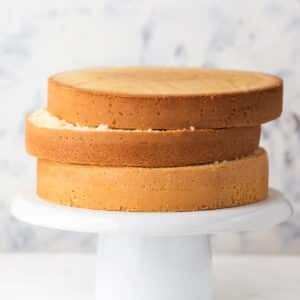Genoise Sponge Recipe
Super light and airy Genoise sponge cake, perfect for layer cakes and desserts.
Servings: 1 8 inch cake
Ingredients
- 4 Large Eggs
- ¾ cup Granulated Sugar 150g
- 1 cup Cake Flour 114g
- 3 tablespoon Vegetable Oil 35g / 45ml
- 2 tablespoon Whole Milk 30g / 30ml
- 1 teaspoon Vanilla Extract
Instructions
- Preheat oven to 350°F / 180°C and grease an 8-inch cake pan.
- Make a bain-marie (double boiler) by placing a heatproof bowl over a saucepan with about an inch of water in the bottom. Make sure the bottom of the bowl is not touching the hot water. Let the water come to a simmer and then add the sugar and whole eggs, whisk to combine.
- Warm the egg mixture gently on the double boiler, whisking well the whole time, until the sugar has dissolved. You can check by rubbing the mixture between your fingers - if it's grainy it needs longer. The mixture should not get hot at any point, just warm enough to dissolve the sugar, which should only take a few minutes.
- Transfer the egg mixture to a stand mixer with a whisk attachment. Whip on the highest speed setting for 5 full minutes. Once it's done it will be very pale and should have doubled in volume. Test if it's ready by drizzling a little of the batter on top of itself - if the pattern stays on the surface for a few seconds then it's good. If it disappears immediately, whip for another minute.
- Turn the mixer down to low speed (the lowest setting) and whip for a further 10 minutes. This knocks all the large air bubbles out while keeping the smaller ones, which makes for a smoother and more consistent batter and a nice airy cake.
- While the eggs are whipping, you can prepare the other ingredients. Sift your flour into a large mixing bowl (sift twice for best results), and in a separate bowl mix together the milk, oil, and vanilla.
- Add the sifted flour to the whipped eggs and fold it in carefully with a rubber spatula. Be as gentle as possible here because knocking the air out will mean the genoise cake can't rise.
- Take a large dollop of the mixture and put it into a separate bowl. Then add the wet ingredients. Mix them together thoroughly. This is called 'sacrificing' the batter - the air will be knocked out of it, but it will help the liquids to incorporate into the rest of the cake batter more easily.
- Once totally combined, pour the 'sacrificed' batter back into the main batter and fold in gently until combined. Keep folding until it reaches the 'ribbon stage'. This means that if you lift your spoon or spatula out of the batter, the batter should run off the spoon steadily in a flowy, ribbon-like motion. If it hasn't reached this stage yet, keep folding gently.
- Pour the batter into your prepared cake pan and tap the pan on the counter a few times to release any large air bubbles. Place it into the preheated oven and bake for 35 minutes, or until the top is golden brown and bounces back slightly if you press on it. Baking time will vary depending on your oven, so make sure to check it regularly.
- Remove from the oven and bang the cake pan on the counter again to release additional air bubbles and prevent the sponge cake from collapsing while it cools. Put a piece of parchment paper on top of a wire rack and flip the cake upside down on the rack - let it cool like this. Don't worry if the cake immediately falls away from the bottom of the pan. Once it's cool enough to touch, remove the cake pan and let the cake cool completely (upside down).
Notes
The bake time in this recipe is for one 8-inch cake pan. You can also split the same batter into two 8-inch cake pans and reduce the baking time to about 20 minutes. Make sure you check regularly if it is done to avoid overbaking.
Oil vs Butter
You can use melted butter instead of oil in this recipe if you prefer. It will give a richer flavor but may make the cake slightly more dense and it won't rise as much. If you do use butter, sub for the same amount of melted butter and be sure to add it to the batter while it's warm.
